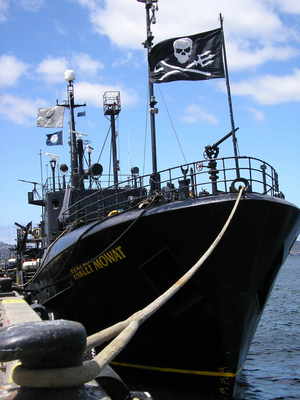When the cable channel Animal Planet aired its semi-reality show called Whale Wars recently, I grew interested in the program because I’d been reading a recently published book about whaling titled Harpoon by Australian author Andrew Darby (da Capo Press). The book mentions Paul Watson of the Sea Shepherd Conservation Society who is the focus of the show Whale Wars.
I don’t know why the book Harpoon jumped out at me when I walked by it on a back shelf at the local library. Maybe it’s one of those books I was “meant to read.” Perhaps it is one of those books everyone should read; because it reveals the farce that international agreements on whaling have turned out to be. Twenty years after whaling was semi-officially “banned” worldwide, some nations continue killing whales under the lame excuse of “science.”
All told, the history of whaling is not a pretty business. The world’s whale stocks were almost wiped out by whalers until groups like the International Whaling Commission (IWC) decided that quotas had to be established to protect whales. A visit to the IWC web site (http://www.iwcoffice.org/commission/iwcmain.htm#history) is depressing in what it reveals about international perspectives on whaling. On the front of the web site there are rather hopeful pictures of whales breaching the surface of the ocean. But dive below the surface of the site and you’ll find that the bottom line in whaling comes down to a legal disclaimer that is chilling in what it reveals about the net authority of the IWC. Right below a “LIST OF MEMBER NATIONS” (Total 82) is a clear concession to the reality that some nations will never agree to play by the rules when it comes to whaling. The disclaimer is almost childish in its positioning, like something from the cartoon strip Calvin & Hobbes in which a young boy and his stuffed tiger agree there are no rules when it comes to their favorite game, “Calvinball:”*
THE OBJECTION PROCEDURE (Convention Article 5 (3))
Any government can ‘object’ to any decision that it considers to seriously affect its national interest, provided it is done within 90 days of notification of the decision. Should this happen, further time is allowed for other governments to object. The government or governments that object are not then bound by that particular decision. This mechanism has been strongly criticised as rendering the Commission ‘toothless’, but without it the Convention would probably have never been signed. In addition, without such a right (common to many international agreements), a government would still have been able to withdraw from the Convention and thus not be bound by any of the regulations.
In other words, there really are no international laws when it comes to whaling. Countries can claim any reason they want as justification to kill whales and then go do it. It turns out whaling is considered an important tradition if not a downright religious act of identity to certain nations in the world; Norway, Iceland and Japan in particular, and the International Whaling Commission puts those interests ahead of the lives of thousands of whales annually.
In the past, some nations that participated in whaling had no traditions at all to uphold. To the Soviet bloc whalers who cruised the South Pacific in the early part of the 20th century, whales were meat and blubber, and that was that. They reported half of what they caught and slaughtered species that were supposedly protected by quotas. No one dared challenge the Soviets with the impending Cold War building on the world front.
So there you have it: The history of whaling is a nasty mix of international politics and ruthless greed. While some whalers express regret once they’ve moved on from their pelagic killing fields, a few remain wistful for the days when whales were abundant and the hunt was on. Andrew Darby’s “Harpoon” ably chronicles the emotions that center on whaling, for better or worse. And it’s mostly the worst of human nature.
Most people are familiar with the basic concept of whaling. Men in ships cruise the ocean looking for pods of whales. Then they aim harpoons at crucial spots on the whale and hope it kills the animal. Then the whales are hauled on deck where they are carved up like giant turkeys.
There are more than 40 types of whales in the world, some of which have proven more commercially valuable than others. Oil extracted from whales was used to make various products through the 19th century when industrialization and discovery of alternative raw products largely replaced the need for whale products worldwide.
Yet some countries keep on whaling for oil, meat and blubber. Hundreds of thousands of whales have been killed over the last century and a half. The process of killing a whale by most accounts remains horribly inexact and gruesome. Some call it inhumane. Harpoons certainly seem deadly with their metal barbs and piercing hooks, but they rarely kill a whale quickly. One harpoon almost never does the trick, a fact first documented on video by Greenpeace and others in the late 1960s. Greenpeace films showed whales suffering up to half an hour while the whalers winch them toward the boat.
Exploding grenade harpoons and harpoons with expanding ends help disable a whale, but do not hasten its death much. Consider the chore: The biggest whales like blue and gray whales are the largest animals that have ever lived on the earth. Placing a killer shot to the vital organs may slow them down, but it can take up to six or seven harpoons and as much as an hour or so for many whales to die.
Industrial whaling ships mined the world’s oceans for years following a cold measure of stock called the BWU, or Blue Whale Unit. As the biggest species of whale in the oceans, Blue Whales became the measurement on how much meat and blubber whalers could haul on deck with every kill.
As Andrew Darby chronicles in his book Harpoon, secrecy about total take by whalers has always been and remains a problem. The whole business of whaling seems founded on layers and layers of lies about what type and how many whales are killed in a given season. Then euphemism about whales being killed for the purpose of “science” entered the picture, and no one could seem to get a grasp on how to manage whales in international waters. Conservation became the buzzword among those seeking to protect whales, but the same term could be applied by those trying to kill whales if they made the argument that killing whales in the name of science really was serving the interests of conservation.
With all this vigilantism on the surface of the ocean, it is no surprise that people began stepping outside the law to protect whales at any cost. That’s how Greenpeace and the Sea Shepherd Conservation Society came into being. The two organizations disagree over how best to document and prevent whaling, a relationship shown to be petty, snarky and immature if the show Whale Wars holds any truth to it. It also shows the Sea Shepherd’s dangerously idealistic approach to harassing whalers. Basically the Sea Shepherd trains a stable of neo-hippies to throw stink bombs at Japanese whaling ships. They ride around the ocean in their pirate cruiser the Sea Shepherd hoping to bump into the Japanese fleet. Their mishaps with Zodiac boats and helicopters are frightening in their naiveté. Through it all, leader Paul Watson seems not to know what’s going on, taking a hands-off approach to his stock and trade of international lawlessness. You have to admire the fact the man has raised enough money to buzz around the world chasing whalers and protecting whales, but from the depiction of the man in the show “Whale Wars,” Paul Watson seems like a disturbingly detached anti-hero at the helm of an idealistic pirate ship. He is not a man I would choose to follow, but his crew seems committed to saving whales, if we allow ourselves the ultimate cliche in conservation terms.
I will admit that I personally have never seen a whale in the wild. What I have seen are cetacean species such as porpoises. Standing on a breakwater a half-mile out to sea on the Gulf Coast of Texas, I was scanning the ocean with binoculars looking for sea birds when the muscular gray back of a porpoise broke from the surface and curled back into the water. The sight of a porpoise 30 yards away made me feel somehow lonesome and strange, out of my element standing on the rocks so far out in the ocean. I looked around at the fisherman crouched among the giant rocks lining the breakwater. No one else seemed to notice the porpoise. They were probably used to the sight of these large mammals so close. Still, it was an amazing sight.
The smooth-skinned mammal crested again but never lifted its face out of the water, and so remained a mystery. As it dove a small bit of spray kicked up behind its tail. The feeling I got from watching this creature was raw, natural power. It did not move fast, just purposefully. Overall you got a feeling of remote sentience, a creature at home in its element. I could not imagine killing such a thing, much killing less a mammal10 or 20 times bigger than the porpoise.
As a long time birder and naturalist who has seen large wild creatures on land from buffalo to eagles to pronghorn antelope, I am certain the majesty of seeing a whale break surface in the open ocean is a humbling and profound experience, which accounts for the popularity of ecotours and whale-watching trips. Whales represent the wild for many people. But there are still plenty who do not seem to care whether whales survive in the wild or not. And there are probably plenty of people who don’t care that men go around shooting exploding harpoons into the flesh of sentient mammals. But we no longer need to do this for human survival or industry. So we should stop it.
It is perhaps not surprising that people of principle and clear ideals of about saving whales have taken the law into their own hands across the earth’s oceans. It may be an imperfect response to the flawed human enterprise in whaling, but it is a response that will likely need to continue until the world’s conscience grows mature enough to stop whaling in its own wake.
*Calvinball from the strip Calvin and Hobbes is itself is an ironic play on words about the notion of pre-destination and the theology of “Calvinism,” which contends that our lives are fixed expressions of God’s will. The reference here in relation to the International Whaling Commission illustrates the sad concept that the supposedly presiding body for international whaling does not enforce its own rules.


